Divyaroop Bhatnagar's Blog, page 2
May 23, 2021
A Malthusian Twist in the Pandemic Tale
"The increase of population is necessarily limited by the means of subsistence"
When Malthus wrote these words in the late 18th Century, he was at odds with the general view that "society was improving and in principle perfectible" - Wikipedia. The onset of the Industrial revolution fueled by monies extracted from the colonies led to a feeling of invincibility and perpetual growth during the Victorian era in Europe, which at that time was clearly the heart of the world with Britain at its core. Two world wars, several recessions, famines and earlier pandemics were not able to puncture the boundless optimism first sparked off by Vasco Da Gama in 1498 when he knocked on India's gate and laid the foundation for the Western World's wealth.
The point being made is, of course, about 'endless growth and development' and eventually thus the possibility of perfection. Related questions about science, ingenuity and whether these and other enablers have their limits too will come up when we examine these areas. It is not quite what Malthus intended to say but the import is similar. If anything, the advances in science are best exemplified by the 'warp speed' at which vaccines for Covid 19 have been developed. This should have been a good augury for the future - signifying a positive, forward looking, optimistic approach with a firm belief in science and technology at the heart of it. Almost Victorian as it were.
And yet an ominous lassitude seems to have come over us. In a curious, Malthusian twist, birth rates are plummeting around the world. The Western world and countries like Japan were facing this problem anyway but now the contagion has spread. Even countries like India are almost at replacement birth rate and the trend is accelerating rapidly. The pandemic has brought the fear of the future to our doorsteps. An uncertainty has us in its grip. You need to be optimistic about the future to procreate. Assuming that the pandemic will eventually recede, it may leave an exhausted, jaded world in its wake.
That would be the Malthusian Twist in the Pandemic Tale.
Ref: https://www.nytimes.com/2021/05/22/wo...
When Malthus wrote these words in the late 18th Century, he was at odds with the general view that "society was improving and in principle perfectible" - Wikipedia. The onset of the Industrial revolution fueled by monies extracted from the colonies led to a feeling of invincibility and perpetual growth during the Victorian era in Europe, which at that time was clearly the heart of the world with Britain at its core. Two world wars, several recessions, famines and earlier pandemics were not able to puncture the boundless optimism first sparked off by Vasco Da Gama in 1498 when he knocked on India's gate and laid the foundation for the Western World's wealth.
The point being made is, of course, about 'endless growth and development' and eventually thus the possibility of perfection. Related questions about science, ingenuity and whether these and other enablers have their limits too will come up when we examine these areas. It is not quite what Malthus intended to say but the import is similar. If anything, the advances in science are best exemplified by the 'warp speed' at which vaccines for Covid 19 have been developed. This should have been a good augury for the future - signifying a positive, forward looking, optimistic approach with a firm belief in science and technology at the heart of it. Almost Victorian as it were.
And yet an ominous lassitude seems to have come over us. In a curious, Malthusian twist, birth rates are plummeting around the world. The Western world and countries like Japan were facing this problem anyway but now the contagion has spread. Even countries like India are almost at replacement birth rate and the trend is accelerating rapidly. The pandemic has brought the fear of the future to our doorsteps. An uncertainty has us in its grip. You need to be optimistic about the future to procreate. Assuming that the pandemic will eventually recede, it may leave an exhausted, jaded world in its wake.
That would be the Malthusian Twist in the Pandemic Tale.
Ref: https://www.nytimes.com/2021/05/22/wo...
Published on May 23, 2021 06:30
March 9, 2021
Delhi to Chennai by Road - An Indian Odyssey
The Pandemic seems to have fueled a number of off beat passions. One of mine is road trips. Anyway, the lockdown provided enough time to plan a journey that I had been dreaming of for years. A road trip from Delhi to Chennai. We were fortunate that Devi's brother, Velu, and his wife, Sarada, flew up to Delhi from Chennai to drive back with us. The itinerary went back and forth for a while but eventually emerged as a fairly leisurely ramble from North to South with a focus on Madhya Pradesh.
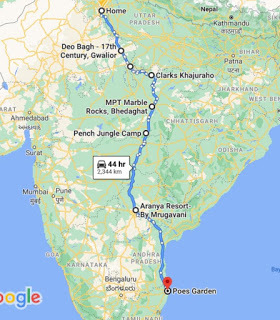
We planned 6 stops along the way, breaking the nearly 2400 Km journey into manageable bits. Finally, it looked like this:
Day1: Gurgaon to GwaliorDay 2: Gwalior to OrchhaDay 3: OrchhaDay 4: Orchha to KhajurahoDay 5: Khajuraho to Beraghat (Jabalpur)Day 6: Beraghat to Pench National ParkDay 7: Pench National ParkDay 7: Pench to HyderabadDay 8: Hyderabad to Chennai
This blog will not focus too much on the historical aspects of places visited but more on the travel and sightseeing that you can expect.
Day 1We set off at 6:20 am from Gurgaon. The route we chose was via the Yamuna Expressway to Agra, then through Agra City to join the Gwalior Road. It was a toss up between using the old Delhi Agra road which has an Agra bypass vs the Expressway. The time taken is roughly the same (around 7 hours including a breakfast/loo stop). We avoided eating at roadside places and ate a packed breakfast instead. The drive through Agra was bad and the Agra Gwalior Road even worse. There was an army convoy with many trucks going in the same direction that slowed things down. The toll plazas on the Yamuna Expressway do not accept Fast Tag and the toll plazas on the Agra Gwalior Road are chaotic. The saving grace was the delicious guavas that we bought near Agra. The river Chambal on the way was also beautiful.
We checked in to the Neemrana Deo Bagh Hotel at Gwalior and I must say this is a phenomenal hotel! Set in a 17th Century Garden with old cenotaphs, temples and a baradari right on the premises interspersed with fruit trees and flowers, it is a delight. The food is excellent, simple but well cooked and the service is wonderful. Clearly a great option for staying in Gwalior.
After a quick lunch we left for the Jai Vilas Palace, full of the pomp and grandeur of the Scindias. Furnished largely in European style complete with crystal and Murano glass chandeliers. It has a little train that carries brandy and cigars for the men folk on the dining table after the banquet and other such expensive fripperies from the age of the Maharajahs. We had a guide who was quite knowledgeable about the palace.
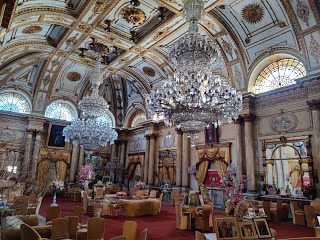
We then went to Gwalior Fort. This is a beautiful structure that has been in existence from roughly the 6th Century CE. There are Jain temples as you drive up and Hindu temples and a Gurudwara on top. Our visit was a bit hurried - it may be a good idea to provide a full day at Gwalior and that would mean staying 2 nights. We saw the sound and light show also - Amitabh Bachhan's baritone lauding the deeds of successive owners of the fort. The setting is magnificent.
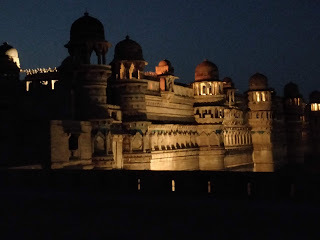
Day 2After a relaxed breakfast, we left Gwalior for Orchha. This is a 3 hour drive without stops but there are a couple of places in between that are worth stopping in. The road is fairly good all the way. Orchha does not have a petrol pump so it is advisable to fill up before getting there. It's also nice to plan a 2 night stay at Orchha as there is plenty to see.
Datia is the first point to stop for a while. The palace is supposed to have provided Lutyens with a role model for Rashtrapati Bhavan. Possible, but I did not see the architectural similarity that clearly. We saw it only from the outside but a more relaxed trip may be worthwhile.
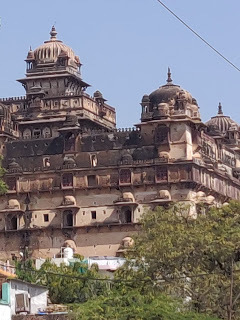
After Datia you come to Jhansi where a visit to the Fort is worthwhile. It is a bit bare but the history and symbolism of Jhansi ki Rani make it a must visit. Parking is available easily.
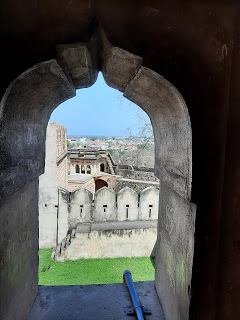
Orchha is a short drive from Jhansi. We stayed at the MP Tourism Betwa Retreat as we thought that the tents overlooked the Betwa River. They do not and hence the place was a tad disappointing. However, it more than made up on the service front. The dynamic Manager, Sanjay Malhotra and his team were really helpful at all times. The Betwa Riverside Hotel is probably the only one on the river and the most luxurious seemed to be the Amar Mahal. There is also a MP Tourism place inside the palace that may be an option. Mr Malhotra packed us off for river rafting after lunch. A jeep picked us up from the hotel and took us to the starting ghat which is near the chattris. This was one of the best experiences of our trip. It's not as dramatic as the Ganga near Rishikesh but the river is simply beautiful. The rapids are gentle and the water is crystal clear. Some of us jumped in. The sun was setting and the sight of the palaces and the cenotaphs is breathtaking. A peacock was perched on a rock by the side of the river while a cormorant waited for fishes to swim past. An amazing experience!
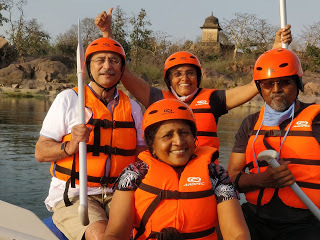
After the rafting we went off to the palace for the sound and light show. The English show was at 7 pm. This was a 10 min drive from our hotel opposite the Ram Raja temple. Many people also attended the Aarti at 6:30 pm but we avoided it due to Covid. Don't park on the bridge but go further into the palace. There is plenty of parking available there. The sound and light show is a useful way of getting a brief history lesson. One of the main rulers of Orchha was Madhukar Shah and the legend of how his second queen brought back a statue of Ram as a baby to Orchha is very endearing. Based on that, the whole town is modeled on Ayodhya.
Food in the hotel was good. They serve liquor but you may like to carry your own as well.
Day 3We started the day with a heritage guided walk around the Fort and the Palace at 7 am. Please do ensure that you book this in advance with the hotel. It is not a scheduled walk in that sense. Our guide, Jeetendra was truly outstanding with a wealth of knowledge about Orchha and Indian History in general. We went back to the hotel for breakfast at 8:30 am to return an hour later for the visit to the Fort and the Palace. Here again, taking a guide is important (we had Jeetendra again) though audio guides are also available. His commentary on the so called Jehangir Mahal was interesting as well as the stories of the renowned dancer, Rai Praveen and the paintings on the walls and ceilings inside the main palace.
We returned to the hotel for a late lunch and some rest before walking out to see the chattris (cenotaphs) on the banks of the river at sunset. These are a 10 minute walk from the hotel.
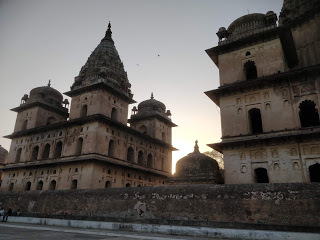
There is a beautiful garden behind the chattris that you have to pay Rs 20 to get into. It is well worth it. An early dinner and bed after a tiring day.
Day 4We got up early and went back to see the chattris at dawn. The river is so beautiful and the monuments create a feeling of nostalgia and romance. We walked back to the hotel for a shower and set off for Khajuraho after breakfast. The drive is around 5 hours so we reached our hotel, Clarks Khajuraho at 3 pm. Please follow the route that Google recommends. The main highway was under construction when we visited and was avoidable. Our drive was really beautiful through the forest. A single road so you can't go fast but worth it for the views.
Clarks Khajuraho lives up to it's promise of 'Affordable Luxury' There are better hotels in Khajuraho but for one night's stay this is a good option. The rooms are dated but comfortable and they have extensive gardens that are nice for walking in. After a snack we headed off to the Western (main) group of temples. Find your way to the VIP Parking and get a good guide. Buying an entrance ticket was unexpectedly complicated by the online process.
What can one say about Khajuraho that has not been said already? My dominant feeling was of regret about the magnificent culture and civilization that is our heritage. Years of Islamic and Christian Invasions have trampled on the soul of India. I hope we get it back soon. Suffice it to say that Khajuraho does not disappoint. It leaves you awestruck. We had a snack at Raja's Café after the temple visits and then went across for the sound and light show. The setting was spectacular in the park where the Western Group is located and it leaves you with a very pleasant feeling. Then back to the hotel for dinner.
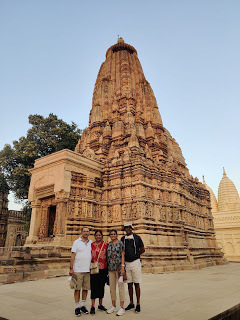
Day 5We checked out of the hotel after breakfast for the drive to Jabalpur. The drive is around 5 hours and there are several alternative routes. Take the one that Google suggests. It is again a pretty drive through the forest. At the last point it joins the highway and there is some construction. We stayed at Beraghat for the marble rocks and there are not many hotel options. We stayed at the MP Tourism place in tents but again there is no view of the river. Service and maintenance is quite poor. There are not many options in Beraghat so we had to make do with the MPT place. Food was OK. After a snack we left for the Dhuandhar falls. Take the cable car across the river Narmada for a good view. Access to the river is also less crowded on the other side. The falls are beautiful.
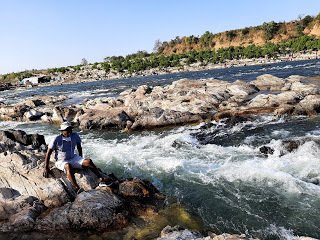
After the falls, we drove across to the ghat where the boating starts. This is just a 10 min drive and parking is easy to find. The boat ride to see the marble rocks is spectacular. Please extend the half hour ride by directly paying the boatman. It's well worth it. An amusing sidelight is the running commentary by the boatman. He spoke in doggerel and it was simply hilarious.
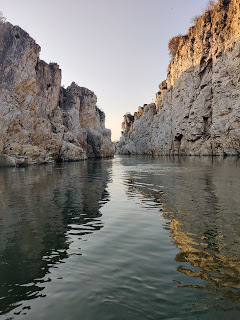
Day 6We left Beraghat after breakfast for the Pench National Park. The road is very good with the highlight being the 16 Km elevated road that has been built over the Pench National Park to provide free access for animals to cross. This is in Southern MP and a part of it also lies in Maharashtra. This is a lesser known tiger reserve. The forest is mostly Sal trees and the weather is quite dry.
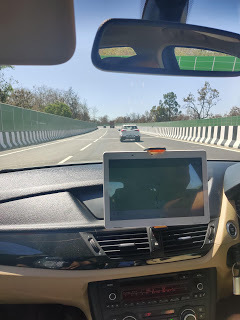
We stayed at the Pench Jungle Camp and it is a very good option. The architecture is unobtrusive and the tents and bathrooms are great. Food is also good and the Naturalist is knowledgeable. We had lunch and headed out for a Safari. We were lucky to see a tiger but she was at a distance and we didn't get any photos. Clearly if you are into wildlife watching you need a better camera than a cell phone!
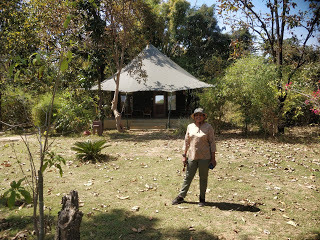
Day 7Two Safaris at Pench. We saw a leopard eating his kill but again our cameras were inadequate.
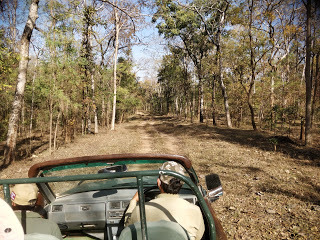
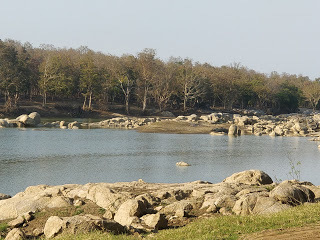
Day 8We made an early start with a substantial packed breakfast. and as promised by them the food lasted us till we reached Hyderabad in the evening!! The intention was to drive straight through Maharashtra as the Covid cases were increasing. The road is excellent and we made good time all the way to Hyderabad. I had chosen a resort near the Outer Ring Road called Aranya and it was a bad choice. Poor hygiene and bad food. Devi's cousin Meena and her husband Ram joined us for dinner and they brought with them some excellent pomfret and single malt so the evening was great! The roads around Hyderabad especially the Outer Ring Road are very good.
Day 9The last day. Again made an early start. Aranya redeemed themselves somewhat by providing an excellent packed breakfast. We made good time passing by the lush green paddy fields of Coastal Andhra on the way all the way to Poes Garden in Chennai.
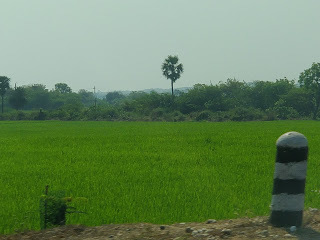
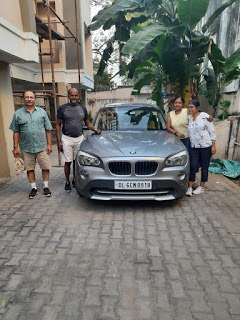
Roads have improved tremendously. We did encounter some widening work and over bridges being constructed but it was manageable. What is disappointing are the toll plazas. Haphazard lines, terrible speed breakers, some of the sensors don't work etc. It appears that the Expressways have not been integrated with this system so you zip over the Yamuna Expressway and then spend 15 minutes at each toll plaza. State Highways are also not integrated. The total toll we paid from Gurgaon to Chennai was around Rs 2500 - quite a bit but no regrets as the roads were generally good.
Here is a link to some photos from the trip. Would love to hear your feedback.
Delhi Chennai Photos
Published on March 09, 2021 20:35
June 8, 2020
Covid 19 Projections for India
Based on my earlier blog, I had developed a projection for Covid 19 progress in India. There have been two presentations so far on 24.05.20 and on 8.06.20.
Links to the slides are given below. I would welcome your views.
https://www.slideshare.net/divyaroop/covid-19-stats-in-india-240520
https://www.slideshare.net/divyaroop/covid-19-stats-in-india-update-1-80620
Links to the slides are given below. I would welcome your views.
https://www.slideshare.net/divyaroop/covid-19-stats-in-india-240520
https://www.slideshare.net/divyaroop/covid-19-stats-in-india-update-1-80620
Published on June 08, 2020 08:58
May 19, 2020
By when will Covid 19 start declining in India?
Like many of us, I have also been keenly following the numbers on the Covid 19 Pandemic. Since we live here, the focus is more on India and what is going to happen. I had developed a model to forecast by when we would start seeing a decline in deaths in India that I shared with family and friends.
Rather reluctantly, on their urging, I am sharing the findings on my blog. Please note that this is strictly an amateur's work. If the predictions don't pan out, well it will be no worse than some of the astrologers who are now running for cover!
Here goes:
Here is where I stick my neck out. I have done an international per capita model of cases and deaths and used it to forecast what will happen in IndiaBroadly there are 3 types of countries and progression of Covid 19. Asia including Turkey and Iran where the disease progressed more rapidly and counties like Malaysia and Thailand which have hardly been touched at all.Europe and North America which are broadly similarBrazil is still to stabilizeI have taken the dates on which a decline started of cases and deaths for each country and worked out the per capita cases and deaths on that dayThis analysis results in the conclusion that India is likely to behave like West Asia - tropical counties of Malaysia, Indonesia and Thailand will do better than India.Deaths are more reliable than cases as a measure for forecasting as cases are dependent on how much testing is going onBased on the above analysis, my prediction is that India deaths/day will start declining around 1 July to 10 July. The number of deaths in India (based on a 7 day moving average are doubling in 12 days) will reach the projected number of 35,000 - 62,000 after which they should start declining as per the model.The decline will start earlier in places like Ahmedabad, Pune and Mumbai where the spread is already greater. However, as a whole the country will start seeing the decline on the dates stated above.This model assumes that the per capita infections and deaths when they reach a certain level in the population the infection progress recedes. It must be something similar to herd immunity but the pundits are reluctant to use that wordThe more you ease off from the lockdown, the quicker we will reach the tipping point. The doubling rate will become quicker.It would be great to hear your reactions on this post.
Regards and stay safe.

Rather reluctantly, on their urging, I am sharing the findings on my blog. Please note that this is strictly an amateur's work. If the predictions don't pan out, well it will be no worse than some of the astrologers who are now running for cover!
Here goes:
Here is where I stick my neck out. I have done an international per capita model of cases and deaths and used it to forecast what will happen in IndiaBroadly there are 3 types of countries and progression of Covid 19. Asia including Turkey and Iran where the disease progressed more rapidly and counties like Malaysia and Thailand which have hardly been touched at all.Europe and North America which are broadly similarBrazil is still to stabilizeI have taken the dates on which a decline started of cases and deaths for each country and worked out the per capita cases and deaths on that dayThis analysis results in the conclusion that India is likely to behave like West Asia - tropical counties of Malaysia, Indonesia and Thailand will do better than India.Deaths are more reliable than cases as a measure for forecasting as cases are dependent on how much testing is going onBased on the above analysis, my prediction is that India deaths/day will start declining around 1 July to 10 July. The number of deaths in India (based on a 7 day moving average are doubling in 12 days) will reach the projected number of 35,000 - 62,000 after which they should start declining as per the model.The decline will start earlier in places like Ahmedabad, Pune and Mumbai where the spread is already greater. However, as a whole the country will start seeing the decline on the dates stated above.This model assumes that the per capita infections and deaths when they reach a certain level in the population the infection progress recedes. It must be something similar to herd immunity but the pundits are reluctant to use that wordThe more you ease off from the lockdown, the quicker we will reach the tipping point. The doubling rate will become quicker.It would be great to hear your reactions on this post.
Regards and stay safe.

Published on May 19, 2020 02:09
May 3, 2020
We Deserve our Slums
Indians are masters at avoiding uncomfortable truths.
Are we racist? Yes - if only you would stop to hear the racial slurs that we cast on Blacks or even our own people with darker skins. How many dusky little girls have been taunted by the ditty "Kali kaluti, baingan luti. Bhare bazaar mein dham dham kuti." Are we elitist? Yes - in our condominium block in Gurgaon there was a vigorous debate on whether maids and drivers should be allowed to use passenger lifts - there are only two lifts, one for 'passengers' with the other one being labelled 'service lift' Are we casteist - Social distancing was just made for us. Untouchability still thrives in rural areas, however much we may like to deny it. And finally are we anti Muslim? The biggest elephant in the room today.
This blog post is not intended to recite a litany of the ills that beset Indian society. Rather, I will focus on only one that is perhaps derived from some or all of the above.
Simply put, we are a mean people. We drive past Dharavi in our air conditioned cars and turn up our noses at the whiff of fecal matter that manages to make it past the filtration system. Why doesn't the administration clear these slums for heaven's sake? Why do we pay taxes? The govt just does not do anything!
The uncomfortable truth is really very simple. If we are only willing to pay a plumber Rs 800 per day or even less in the smaller towns, he will earn around Rs 16,000 or so per month. So will a driver or a blue collar worker in a factory. On that, he has to rent a little kholi, commute, eat, provide for clothes and education for his family and hope that he does not fall ill as if he does he is not likely to able to afford decent medical care. Perhaps the family may earn a little more if his wife works in one or more of our households as a maid. Our 'low costs of labour' are like a millstone round our necks. They condemn our working classes to a life of penury amidst filth, disease and no prospects of growth. Can we seriously question why we have slums? They are the places where we condemn those who work for us to live.
We deserve our slums.
Read my nostalgic collection of short stories set in Mussoorie in the 1960s. Amazon is delivering the Kindle Edition these days. Stay safe. Click to buy
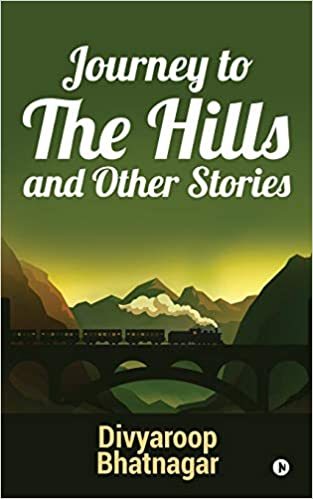
Are we racist? Yes - if only you would stop to hear the racial slurs that we cast on Blacks or even our own people with darker skins. How many dusky little girls have been taunted by the ditty "Kali kaluti, baingan luti. Bhare bazaar mein dham dham kuti." Are we elitist? Yes - in our condominium block in Gurgaon there was a vigorous debate on whether maids and drivers should be allowed to use passenger lifts - there are only two lifts, one for 'passengers' with the other one being labelled 'service lift' Are we casteist - Social distancing was just made for us. Untouchability still thrives in rural areas, however much we may like to deny it. And finally are we anti Muslim? The biggest elephant in the room today.
This blog post is not intended to recite a litany of the ills that beset Indian society. Rather, I will focus on only one that is perhaps derived from some or all of the above.
Simply put, we are a mean people. We drive past Dharavi in our air conditioned cars and turn up our noses at the whiff of fecal matter that manages to make it past the filtration system. Why doesn't the administration clear these slums for heaven's sake? Why do we pay taxes? The govt just does not do anything!
The uncomfortable truth is really very simple. If we are only willing to pay a plumber Rs 800 per day or even less in the smaller towns, he will earn around Rs 16,000 or so per month. So will a driver or a blue collar worker in a factory. On that, he has to rent a little kholi, commute, eat, provide for clothes and education for his family and hope that he does not fall ill as if he does he is not likely to able to afford decent medical care. Perhaps the family may earn a little more if his wife works in one or more of our households as a maid. Our 'low costs of labour' are like a millstone round our necks. They condemn our working classes to a life of penury amidst filth, disease and no prospects of growth. Can we seriously question why we have slums? They are the places where we condemn those who work for us to live.
We deserve our slums.
Read my nostalgic collection of short stories set in Mussoorie in the 1960s. Amazon is delivering the Kindle Edition these days. Stay safe. Click to buy

Published on May 03, 2020 23:56
March 6, 2020
AAP - A Method in their Madness?
The AAP certainly seems to have gone through some kind of metamorphosis. Kejriwal reciting the Hanuman Chalisa, presenting flowers to a smiling PM and generally getting along with the current LG are all signs and symptoms of this change.
The graver charge that some of his supporters levy is that he has compromised on his moral principles. He did not come out in support of Shaheen Bagh, he appeared to be aligned with the BJP on the Delhi riots and generally seems to have discarded his activist credentials along with whatever sense of honour he may have had to start with.
To understand this a little better, one has to examine three issues:All in all, India seems to have shifted smartly to the right. It also seems to have become more overtly religious and attitudes have hardened one way or the other. In these fraught times, I feel that Kejriwal has deftly highlighted his own Hindu identity without compromising on his party's secularism. It defangs the more vocal right wing and creates a sort of Hindu nationalist space for Kejriwal that allows him some room to operate. The originator of this strategy being Mahatma Gandhi himself. Rahul Gandhi in his own ham fisted way also visited temples but it was evidently hypocritical and actually hurt the Congress. Kejriwal seems to strike the right notes with his innocent Aam Aadmi look complete with school-boyish sweater and trousers, so one may actually believe him.The second issue is about focus. Kejriwal clearly won a resounding mandate in Delhi due to his track record of good governance. Evidently, the Delhi public sees him as an effective CM who delivers on his promises especially for the poorer segments of people. Do they want him to also be an activist who flaunts his beliefs about the CAA and other contentious matters? How does that help the Delhi voter? Not visiting Shaheen Bagh was clearly a good strategy. In fact the more contentious issues that Kejriwal picks up, the greater the possibility of conflict with the Central Government. Is this worth it? I think not. Let him be one of the few CMs who does what he was elected to do rather than fight random battles. That brings me to my third point about picking the right battles to fight. Kejriwal and his govt have been accused of being conspicuous by their absence during the Delhi riots. It was perfectly clear that the Delhi police's lackadaisical response initially had nothing to do with Kejriwal. He does not control them and can not influence them either. Equally, the sterling work done by the police afterwards had nothing to do with Kejriwal either. He is a sort of truncated CM. Best to remember that and do what you can at the appropriate time. The decision to allow Kanhaiya Kumar to be prosecuted is similar. Why should Kejriwal put himself in the unenviable position of stalling the prosecution of a potential anti national?Whatever his views may be on the subject and whether Kanhaiya is anti national or not, it's better to let the law take it's course and not be seen as an obstructionist. Besides, how does this help with Delhi governance for which Kejriwal has been elected? Aa bail mujhe maar was always a loser's strategy. Fortunately Kejriwal seems to have outgrown this tendency.Make up your minds, folks! Do you want an effective CM who delivers on his promises or do you want a bleeding heart liberal who gets mocked and tripped up at every turn? I think Rahul Gandhi is stepping firmly into the latter profile. More power to him.
I know that this post will cause many liberal folk to froth at the mouth at Kejriwal's perfidy. The cry of the AAP being a B team of the BJP is floating around in Delhi drawing rooms. But do consider that the ability to adapt to changing circumstances while retaining a sharp focus on your objectives is a desirable quality. As the AAP matures, it is heartening to see that Kejriwal is handling this transition with a deft touch. It augurs well for a possible second foray for AAP into politics outside Delhi. If he sheds some supporters along the way especially from the garrulous middle class fat cats so be it. They were never his core target segment.
Take a look at my book of nostalgic short stories set in Mussoorie.
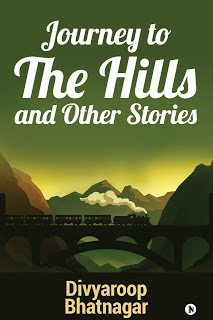
The book has received 5 star reviews from around the world and has been featured in the Amazon hot new releases for travel writing. You can buy it by clicking the link Amazon
The graver charge that some of his supporters levy is that he has compromised on his moral principles. He did not come out in support of Shaheen Bagh, he appeared to be aligned with the BJP on the Delhi riots and generally seems to have discarded his activist credentials along with whatever sense of honour he may have had to start with.
To understand this a little better, one has to examine three issues:All in all, India seems to have shifted smartly to the right. It also seems to have become more overtly religious and attitudes have hardened one way or the other. In these fraught times, I feel that Kejriwal has deftly highlighted his own Hindu identity without compromising on his party's secularism. It defangs the more vocal right wing and creates a sort of Hindu nationalist space for Kejriwal that allows him some room to operate. The originator of this strategy being Mahatma Gandhi himself. Rahul Gandhi in his own ham fisted way also visited temples but it was evidently hypocritical and actually hurt the Congress. Kejriwal seems to strike the right notes with his innocent Aam Aadmi look complete with school-boyish sweater and trousers, so one may actually believe him.The second issue is about focus. Kejriwal clearly won a resounding mandate in Delhi due to his track record of good governance. Evidently, the Delhi public sees him as an effective CM who delivers on his promises especially for the poorer segments of people. Do they want him to also be an activist who flaunts his beliefs about the CAA and other contentious matters? How does that help the Delhi voter? Not visiting Shaheen Bagh was clearly a good strategy. In fact the more contentious issues that Kejriwal picks up, the greater the possibility of conflict with the Central Government. Is this worth it? I think not. Let him be one of the few CMs who does what he was elected to do rather than fight random battles. That brings me to my third point about picking the right battles to fight. Kejriwal and his govt have been accused of being conspicuous by their absence during the Delhi riots. It was perfectly clear that the Delhi police's lackadaisical response initially had nothing to do with Kejriwal. He does not control them and can not influence them either. Equally, the sterling work done by the police afterwards had nothing to do with Kejriwal either. He is a sort of truncated CM. Best to remember that and do what you can at the appropriate time. The decision to allow Kanhaiya Kumar to be prosecuted is similar. Why should Kejriwal put himself in the unenviable position of stalling the prosecution of a potential anti national?Whatever his views may be on the subject and whether Kanhaiya is anti national or not, it's better to let the law take it's course and not be seen as an obstructionist. Besides, how does this help with Delhi governance for which Kejriwal has been elected? Aa bail mujhe maar was always a loser's strategy. Fortunately Kejriwal seems to have outgrown this tendency.Make up your minds, folks! Do you want an effective CM who delivers on his promises or do you want a bleeding heart liberal who gets mocked and tripped up at every turn? I think Rahul Gandhi is stepping firmly into the latter profile. More power to him.
I know that this post will cause many liberal folk to froth at the mouth at Kejriwal's perfidy. The cry of the AAP being a B team of the BJP is floating around in Delhi drawing rooms. But do consider that the ability to adapt to changing circumstances while retaining a sharp focus on your objectives is a desirable quality. As the AAP matures, it is heartening to see that Kejriwal is handling this transition with a deft touch. It augurs well for a possible second foray for AAP into politics outside Delhi. If he sheds some supporters along the way especially from the garrulous middle class fat cats so be it. They were never his core target segment.
Take a look at my book of nostalgic short stories set in Mussoorie.

The book has received 5 star reviews from around the world and has been featured in the Amazon hot new releases for travel writing. You can buy it by clicking the link Amazon
Published on March 06, 2020 07:39
August 17, 2019
Morality? A Rara Avis.
I am in the process of selling a flat in Gurgaon. As I told brokers and buyers that I wanted a 'full cheque' payment (My apologies to any foreign readers who may not understand what this means. What I am referring to is the Indian practice of taking part of the payment in cash, thereby avoiding tax) their expressions ranged from frank incredulity to pity. WHY would anyone want to pay a penny more tax than was absolutely necessary even if the process involves doing something blatantly illegal? Clearly, the process of defrauding the government was being blithely undertaken by all concerned, the government's tall claims of having reduced/eliminated 'black' money notwithstanding. It's a different matter that the colour of the 'black' money is now a bilious pink, given the rather loathsome colour of the new Rs 2000 notes.
Recently, I needed to change the tyres on my car. The dealer offered me 3 alternatives for payment:
Cash - no tax (GST) would be levied. On my asking what would happen to the warranty for the tyres as it would be an unrecorded purchase, the dealer reassured me. "Hum hain na sirji. Tusi nischint raho." Again, the flavour of this statement is typically North Indian. Full of nice sounding insincerity. Cash or Cheque with GST. Here the cost was significantly higher due to the high rates that are applicable under the GST regime.Credit Card - Here an additional 2% would be levied on top of option 2 by the dealer to account for the credit card charges that he had to pay the card company. He was clearly disappointed and a bit contemptuous when I opted for 3. However I manged to mitigate my own stupidity by prevailing upon him to forgo the 2% credit card charge. A small victory indeed!
There are innumerable examples of the traffic police coming up with 'Good Driving Week' where they will challan you if your car crosses the stop line at a traffic light, or for over-speeding or a whole range of minor traffic offences. Once the week is over, it's business a usual with a quiet colloquy with the traffic cop and some money that solves all problems.
It is fair to say that there are some areas where such dishonesty has been reduced or eliminated. Railway reservations, driving licences, passports, etc, largely due to IT that has led to the elimination of touts and brokers. However, the Indian psyche seems to naturally gravitate towards the easy (and cheaper) way out.
So are we an immoral society? The short answer is "yes".
Politicians and Godmen never tire of extolling the virtues of our glorious past. We claim to have have invented virtually everything from aeroplanes to nuclear bombs and we have a monopoly on any intellectual or artistic activity. A truly prolific and talented people indeed! We can be justly proud of the Ramrajya in the past but spare a thought for our immoral present where 'subkuch chalta hai' and businessmen and others revel in the tax that they have evaded and the rules that they have bent!
I wonder when it became socially acceptable to entertain a black-marketer or tax evader in your drawing room. The only problem is that you may lose all your friends and acquaintances if you were to rigidly enforce this rule. Coming to think of it you may be barred entry into your own drawing room as well!
PS - I did finally manage to sell my flat on 'full cheque' payment. Looks like I'm not the only foolish fellow around!
Take a look at my book 'Journey to the Hills and other Stories'. This nostalgic collection of short stories has reached the Amazon bestseller list for travel writing and has been highly acclaimed by readers.
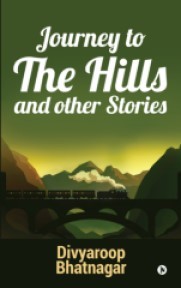
You can buy the book from Amazon. Just click on the Link
Recently, I needed to change the tyres on my car. The dealer offered me 3 alternatives for payment:
Cash - no tax (GST) would be levied. On my asking what would happen to the warranty for the tyres as it would be an unrecorded purchase, the dealer reassured me. "Hum hain na sirji. Tusi nischint raho." Again, the flavour of this statement is typically North Indian. Full of nice sounding insincerity. Cash or Cheque with GST. Here the cost was significantly higher due to the high rates that are applicable under the GST regime.Credit Card - Here an additional 2% would be levied on top of option 2 by the dealer to account for the credit card charges that he had to pay the card company. He was clearly disappointed and a bit contemptuous when I opted for 3. However I manged to mitigate my own stupidity by prevailing upon him to forgo the 2% credit card charge. A small victory indeed!
There are innumerable examples of the traffic police coming up with 'Good Driving Week' where they will challan you if your car crosses the stop line at a traffic light, or for over-speeding or a whole range of minor traffic offences. Once the week is over, it's business a usual with a quiet colloquy with the traffic cop and some money that solves all problems.
It is fair to say that there are some areas where such dishonesty has been reduced or eliminated. Railway reservations, driving licences, passports, etc, largely due to IT that has led to the elimination of touts and brokers. However, the Indian psyche seems to naturally gravitate towards the easy (and cheaper) way out.
So are we an immoral society? The short answer is "yes".
Politicians and Godmen never tire of extolling the virtues of our glorious past. We claim to have have invented virtually everything from aeroplanes to nuclear bombs and we have a monopoly on any intellectual or artistic activity. A truly prolific and talented people indeed! We can be justly proud of the Ramrajya in the past but spare a thought for our immoral present where 'subkuch chalta hai' and businessmen and others revel in the tax that they have evaded and the rules that they have bent!
I wonder when it became socially acceptable to entertain a black-marketer or tax evader in your drawing room. The only problem is that you may lose all your friends and acquaintances if you were to rigidly enforce this rule. Coming to think of it you may be barred entry into your own drawing room as well!
PS - I did finally manage to sell my flat on 'full cheque' payment. Looks like I'm not the only foolish fellow around!
Take a look at my book 'Journey to the Hills and other Stories'. This nostalgic collection of short stories has reached the Amazon bestseller list for travel writing and has been highly acclaimed by readers.

You can buy the book from Amazon. Just click on the Link
Published on August 17, 2019 22:47
April 17, 2019
Colonial Hangover
There are many types of Colonial Hangovers that India suffers from. Many of us are closet anglophiles and have a sneaking admiration for the language and customs of an England, all but forgotten by the English themselves. Brexit is an example of a classic muddled English mess, not to be confused by the food they eat which is messy enough. Having said all this, one of the most pernicious colonial hangovers is our system of Government.
Parliamentary democracy originated in the 'Mother of all Parliaments' in Westminster and was probably appropriate for a small, rain soaked medieval island, struggling to free itself from capricious kings, an effete aristocracy and a dominating clergy. The necessity of an 'Upper House' where the offspring of dukes and earls could be accommodated was probably necessary if you had to maintain a semblance of a monarchy with the attendant trappings of an aristocracy. Why is it necessary in India? Here the Rajya Sabha is full of irrelevant nominees and it's only purpose seems to be to act as a check on the legitimately elected Lok Sabha. Why is such a check necessary? Carrying on the same theme, why must we have a ceremonial President who lives in a 350 room mansion and mimics the ceremonial duties and functions of the Queen of England? It seems totally absurd.
Even more absurd is the relationship between the States and the Centre. Our states are big places with populations of 100 Mn or more. Yet, in our legislation we have a Central list, a State List and hold your hat a Concurrent List of areas where the State, Centre or BOTH can create legislation. If this is not a mess what is? The pathetic situation in Delhi is a case in point where an elected Chief Minister who won by a record margin has to kow tow to a mid level bureaucrat. Surely the States should be competent to run their own affairs and we should not have situations like the GST where we have 3 types of GST to cater to the States and the Centre's wishes.
I could go on in this fashion. What we clearly need is a rethink on the way that Government works in our country. Specifically:
What should be role of the States vs the Centre. As our Economy grows, each state has become a powerful economic entity. Socio-Cultural differences are stark between one State and another. Surely, they should be allowed to manage their own affairs with only a limited role for the Centre?What should be the Governance Structure? Roles and responsibilities need to be defined and the public should be clear about what they can expect from their elected representatives. Are any of us clear about what we should expect from our MPs or MLAs vs the bureaucracy? I for one am not clear at all. If political parties wish to claim that they are the ones who deliver economic prosperity in a physical sense to people as opposed to merely legislation let them define their roles and responsibilities clearly for the public.Delayering and role clarity are some of the mantras of modern management practice. Sadly the reverse seems to be the case in Government. Instead we have multiplicity of roles, lack of clarity of objectives and so forth.What is the role of the IAS? This is a generalist cadre who magically become MDs in highly technical enterprises. They also become Economists almost by osmosis and take on important roles in Finance. Many elected MPs and others complain of the stultifying attitude of the IAS. Surely we need to rethink the role of 'Collectors' - another Colonial Hangover. As of now I for one do not see any thinking or a way forward on any of these issues. Governments come and go but we do not see concrete and meaningful changes in the WAY we work. The net result is that there is very little difference between the performance of one Government and another. They may shout from the rooftops about their contribution and how they are different and better but deep down inside it's all much of a muchness.
India deserves better.
Take a look at my book 'Journey to the Hills and other Stories'. This nostalgic collection of short stories has reached the Amazon bestseller list for travel writing and has been highly acclaimed by readers.

You can buy the book from Amazon. Just click on the Link
Parliamentary democracy originated in the 'Mother of all Parliaments' in Westminster and was probably appropriate for a small, rain soaked medieval island, struggling to free itself from capricious kings, an effete aristocracy and a dominating clergy. The necessity of an 'Upper House' where the offspring of dukes and earls could be accommodated was probably necessary if you had to maintain a semblance of a monarchy with the attendant trappings of an aristocracy. Why is it necessary in India? Here the Rajya Sabha is full of irrelevant nominees and it's only purpose seems to be to act as a check on the legitimately elected Lok Sabha. Why is such a check necessary? Carrying on the same theme, why must we have a ceremonial President who lives in a 350 room mansion and mimics the ceremonial duties and functions of the Queen of England? It seems totally absurd.
Even more absurd is the relationship between the States and the Centre. Our states are big places with populations of 100 Mn or more. Yet, in our legislation we have a Central list, a State List and hold your hat a Concurrent List of areas where the State, Centre or BOTH can create legislation. If this is not a mess what is? The pathetic situation in Delhi is a case in point where an elected Chief Minister who won by a record margin has to kow tow to a mid level bureaucrat. Surely the States should be competent to run their own affairs and we should not have situations like the GST where we have 3 types of GST to cater to the States and the Centre's wishes.
I could go on in this fashion. What we clearly need is a rethink on the way that Government works in our country. Specifically:
What should be role of the States vs the Centre. As our Economy grows, each state has become a powerful economic entity. Socio-Cultural differences are stark between one State and another. Surely, they should be allowed to manage their own affairs with only a limited role for the Centre?What should be the Governance Structure? Roles and responsibilities need to be defined and the public should be clear about what they can expect from their elected representatives. Are any of us clear about what we should expect from our MPs or MLAs vs the bureaucracy? I for one am not clear at all. If political parties wish to claim that they are the ones who deliver economic prosperity in a physical sense to people as opposed to merely legislation let them define their roles and responsibilities clearly for the public.Delayering and role clarity are some of the mantras of modern management practice. Sadly the reverse seems to be the case in Government. Instead we have multiplicity of roles, lack of clarity of objectives and so forth.What is the role of the IAS? This is a generalist cadre who magically become MDs in highly technical enterprises. They also become Economists almost by osmosis and take on important roles in Finance. Many elected MPs and others complain of the stultifying attitude of the IAS. Surely we need to rethink the role of 'Collectors' - another Colonial Hangover. As of now I for one do not see any thinking or a way forward on any of these issues. Governments come and go but we do not see concrete and meaningful changes in the WAY we work. The net result is that there is very little difference between the performance of one Government and another. They may shout from the rooftops about their contribution and how they are different and better but deep down inside it's all much of a muchness.
India deserves better.
Take a look at my book 'Journey to the Hills and other Stories'. This nostalgic collection of short stories has reached the Amazon bestseller list for travel writing and has been highly acclaimed by readers.

You can buy the book from Amazon. Just click on the Link
Published on April 17, 2019 05:22
January 16, 2019
Affirmative Action and School Education
The Wikipedia definition of Affirmative Action is really quite simple
(in the context of the allocation of resources or employment) the practice or policy of favouring individuals belonging to groups known to have been discriminated against previously; positive discrimination.
In India the practice of reservations (the Indian equivalent of affirmative action) in Government schools , colleges and jobs has been mired in controversy and bitterness for decades. The recent move to introduce reservations based on economic status in addition to caste based reservation has created a new dimension. In some ways this goes against the spirit of the original plan for the uplift of people who had suffered discrimination due to the caste system for centuries. On the other hand, it acknowledges the reality of poverty even amongst the upper castes.
In the early '70's when I was a student at IIT Kanpur, the institute started taking in a few scheduled caste candidates. These students had a severe handicap partly because the medium of instruction was English. They had to take remedial classes for a long time before they could comprehend what was going on in the classroom. In addition, since entry standards were relaxed for them their ability to cope with the curriculum was very poor. The IITs also suffered on account of a drop in brand image and perception as top quality institutions. In all respects, the idea of opening up premier institutes of learning to such practices hurts both the students that it tries to help as well as the institutes themselves.
In my view the practice of reservation as carried out in India since independence is a lazy government's easy way out.
If we are serious about creating a level playing field the starting point is to ensure that high quality school education is made available universally. After that, individual merit will take a young person to the best colleges where scholarships and tuition waivers can be made available to needy students. Thereafter jobs will need no reservations as all applicants will be evaluated on merit alone. Let us examine how we have performed as a nation in the critical area of school education.
India is a young country.
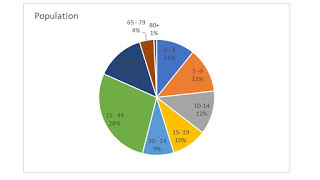 34% of the population is of school going age. This corresponds to over 400 Mn children (Census of India) who should have access to high quality education. This includes about 288 Mn upto class 10 and the balance upto Class 12.
34% of the population is of school going age. This corresponds to over 400 Mn children (Census of India) who should have access to high quality education. This includes about 288 Mn upto class 10 and the balance upto Class 12.
To service these huge numbers, India has an estimated 14,65,000 schools:
No of Schools in India (FICCI/E&Y Study) Government 8,18,000 Local body/muncipal 3,09,000 Private aided 1,57,000 Private unaided 1,81,000 Total 14,65,000
As can be seen from the above table, the vast majority (76%) are Government run though they account for only 60% of the enrollment. Government run schools are therefore smaller than their private counterparts.
Clearly, the onus of school education in India lies squarely with the Government and this is where we have miserably failed as a nation. Anyone who has been to a Government school will know that infrastructure is pathetic, the curriculum and text books are outdated and full of errors and most importantly teachers are either absent or if they do come to school at all they spend the day in gossiping and drinking tea. As for the quality of teachers, the less said the better. In many ways the Government school system is a microcosm of the pathetic state of most Government run enterprises, be it the Railways, the healthcare system, the Public Sector, Air India or any of the myriad enterprises that the Government claims to run.
The tragedy is that while the rest of the shebang can carry on, poor school education saps the energy of the nation. Without it the country rests on a very weak foundation. In fact the much touted 'youth bulge' or 'demographic dividend' is fast becoming a liability rather than an asset.
What needs to be done? I have the following thoughts:We need to have a dynamic and dedicated Minister for School Education. A person like Atishi Marlena of the AAP has made a significant difference to Delhi schools. Similarly, if the country is to progress, we need a dedicated, relatively apolitical leader.In the '70s, the Government had handed over the distribution of Nirodh to 6 private companies. Hindustan Lever, ITC, Brooke Bond, Lipton, Tata Oil Mills and Union Carbide. The scheme was a huge success with vastly increased volumes of the contraceptive becoming available in the remotest areas of the country. Similarly, I would recommend that the responsibility for running Government schools should be handed over to the private sector with a clear division of geographical territory. Instead on 6 companies there should be many more with smaller, more focused areas of operation.CSR budgets of companies should be earmarked for school education in addition to government budgetary allocations that are already available. School education in Government schools should be entirely free and universally available to all citizens. Private schools will coexist but the objective would be to make parents actually prefer a Government school education for their children as is the case currently in many parts of the developed world. What would be outcome of such a strategy? Clearly, such strategies take time to bear fruit. However, in 10 - 15 years years time if pursued diligently we should be able to remove the inequities in our school education system. This will, in time, obviate the need for reservations in colleges and Government jobs. As Shakespeare put it, that would be 'a consummation devoutly to be wished!'
Take a look at my book of nostalgic family stories set in Mussoorie
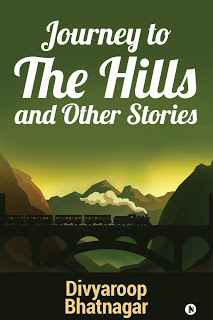
You can buy the book from Amazon Just click on the link.
(in the context of the allocation of resources or employment) the practice or policy of favouring individuals belonging to groups known to have been discriminated against previously; positive discrimination.
In India the practice of reservations (the Indian equivalent of affirmative action) in Government schools , colleges and jobs has been mired in controversy and bitterness for decades. The recent move to introduce reservations based on economic status in addition to caste based reservation has created a new dimension. In some ways this goes against the spirit of the original plan for the uplift of people who had suffered discrimination due to the caste system for centuries. On the other hand, it acknowledges the reality of poverty even amongst the upper castes.
In the early '70's when I was a student at IIT Kanpur, the institute started taking in a few scheduled caste candidates. These students had a severe handicap partly because the medium of instruction was English. They had to take remedial classes for a long time before they could comprehend what was going on in the classroom. In addition, since entry standards were relaxed for them their ability to cope with the curriculum was very poor. The IITs also suffered on account of a drop in brand image and perception as top quality institutions. In all respects, the idea of opening up premier institutes of learning to such practices hurts both the students that it tries to help as well as the institutes themselves.
In my view the practice of reservation as carried out in India since independence is a lazy government's easy way out.
If we are serious about creating a level playing field the starting point is to ensure that high quality school education is made available universally. After that, individual merit will take a young person to the best colleges where scholarships and tuition waivers can be made available to needy students. Thereafter jobs will need no reservations as all applicants will be evaluated on merit alone. Let us examine how we have performed as a nation in the critical area of school education.
India is a young country.
 34% of the population is of school going age. This corresponds to over 400 Mn children (Census of India) who should have access to high quality education. This includes about 288 Mn upto class 10 and the balance upto Class 12.
34% of the population is of school going age. This corresponds to over 400 Mn children (Census of India) who should have access to high quality education. This includes about 288 Mn upto class 10 and the balance upto Class 12.To service these huge numbers, India has an estimated 14,65,000 schools:
No of Schools in India (FICCI/E&Y Study) Government 8,18,000 Local body/muncipal 3,09,000 Private aided 1,57,000 Private unaided 1,81,000 Total 14,65,000
As can be seen from the above table, the vast majority (76%) are Government run though they account for only 60% of the enrollment. Government run schools are therefore smaller than their private counterparts.
Clearly, the onus of school education in India lies squarely with the Government and this is where we have miserably failed as a nation. Anyone who has been to a Government school will know that infrastructure is pathetic, the curriculum and text books are outdated and full of errors and most importantly teachers are either absent or if they do come to school at all they spend the day in gossiping and drinking tea. As for the quality of teachers, the less said the better. In many ways the Government school system is a microcosm of the pathetic state of most Government run enterprises, be it the Railways, the healthcare system, the Public Sector, Air India or any of the myriad enterprises that the Government claims to run.
The tragedy is that while the rest of the shebang can carry on, poor school education saps the energy of the nation. Without it the country rests on a very weak foundation. In fact the much touted 'youth bulge' or 'demographic dividend' is fast becoming a liability rather than an asset.
What needs to be done? I have the following thoughts:We need to have a dynamic and dedicated Minister for School Education. A person like Atishi Marlena of the AAP has made a significant difference to Delhi schools. Similarly, if the country is to progress, we need a dedicated, relatively apolitical leader.In the '70s, the Government had handed over the distribution of Nirodh to 6 private companies. Hindustan Lever, ITC, Brooke Bond, Lipton, Tata Oil Mills and Union Carbide. The scheme was a huge success with vastly increased volumes of the contraceptive becoming available in the remotest areas of the country. Similarly, I would recommend that the responsibility for running Government schools should be handed over to the private sector with a clear division of geographical territory. Instead on 6 companies there should be many more with smaller, more focused areas of operation.CSR budgets of companies should be earmarked for school education in addition to government budgetary allocations that are already available. School education in Government schools should be entirely free and universally available to all citizens. Private schools will coexist but the objective would be to make parents actually prefer a Government school education for their children as is the case currently in many parts of the developed world. What would be outcome of such a strategy? Clearly, such strategies take time to bear fruit. However, in 10 - 15 years years time if pursued diligently we should be able to remove the inequities in our school education system. This will, in time, obviate the need for reservations in colleges and Government jobs. As Shakespeare put it, that would be 'a consummation devoutly to be wished!'
Take a look at my book of nostalgic family stories set in Mussoorie

You can buy the book from Amazon Just click on the link.
Published on January 16, 2019 23:24
December 31, 2018
Journey to the Hills and other Stories
It was a simpler life in the 1960’s. There was no television or hectic activity and families still took long, leisurely summer vacations in hill stations like Mussoorie. An army band played in the evenings at the Band Stand near the Library. Miss Mussoorie contests were the highlight of the season. People took long walks in the glorious sunshine and socialised with their friends on the Mall Road as the sun set over Vincent Hill. The schools were thriving, and summer visitors looked forward to their annual fetes.
These stories are based on the experiences of an extended family during their summer holidays in Mussoorie in the 1960s seen through the eyes of children. So, dear reader, enjoy the gentle charms of a forgotten time and the innocence of childhood as you turn the pages of this little book.
I published my first book, Journey to the Hills and other Stories, in 2012. The stories were written over a period of 8 years when I was still working full time. They were loosely based on our experiences as children during our summer holidays in Mussoorie in the 1960’s. I published them by myself as an experiment on Amazon and Pothi.
I have been astonished and warmed by the response. It’s as if the book has touched a chord in many people who remember their holidays with their extended family with nostalgia and affection. The response has encouraged me enough to revise and expand the book and get it published again. I hope that existing readers will be motivated to pick up the book again and that new ones will be found who are equally nostalgic for the ‘good old days’.
Gone but never forgotten.
You can buy the book from Amazon Just click on the link.
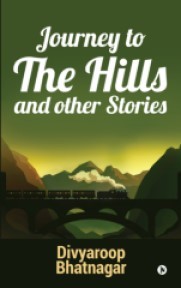 Praise for Journey to the Hills and Other Stories
Praise for Journey to the Hills and Other Stories
Journey of a Masterpiece “…The charm lies in your lucid writing, non-complex plots but the way you wield your pen is worthy of praise. While reading this I feel as if I’m traveling to and in Mussoorie along with Babaji, Dadiji and all. Simple writing filled with sweet humour. Being simple is difficult and this book boasts of simplicity…” Manish Pandey
Puts you in the Scene “…Test Cricket was still played at Green Park’s Modi Stadium in Kanpur where Bhatnagar grew up and he writes vividly about the home and streets in Kanpur and its languid pace in the summer (when historically only mad dogs and Englishmen would step out). Summer meant trips to Nainital or Mussoorie and Bhatnagar describes Mussoorie so vividly that you feel like you are actually there with his family…” Californian
A Relaxing Read “…In writing this tale, Divyaroop is also able to bring out the strong bonding between members of extended families of cousins, uncles, grandparents etc, typical and unique to the Indian family concept…” Ravi. Pisharody
Tales to Relish and Enjoy “…What is really remarkable about the stories is the gentleness with which the author treats each of the characters in the book. The author paints a beautiful picture of a bygone era when hill stations were full of interesting characters and were really used as ‘summer head quarters’ by the affluent families…” Ambi Parameswaran
Beautiful depiction of Hills & life in North India in 1960–70s “…This book is not about giving any gyan or some funda message, and I like that. There seems to be masti and innocence in the air, some interesting family interactions and living lives of solid middle class values. Very nice piece of work. Hope you continue to write with the flair that you have...” Shekhar Srivastava
Nostalgia Personified “…Excellent compilation of stories - you will live the experience even if you have never travelled to this beautiful part of India…” Rahul Sandil
Feedback “…The clarity, imagination, avoidance of all clichés - and much more, persuade me that you simply MUST publish some more.This is simply the most absorbing, unusual, and (for me) amusing, insight into Indian family life in the foothills and below…Your characters are memorable, so true to life… It is a sophisticated ‘children’s book’ on one level… But it also entertains and informs the adult in me: there seems no straining after plot, no melodrama. Children and adults are painted with real insight and fond knowledge. Everyone is rounded, even minor characters. The portraits of Babaji and Dadiji are stunning, and I feel as if I have been welcomed into their holiday home! Far more than a polite chat over tea...The finest portrait of all, perhaps, is Mussoorie itself: I loved all the intimate, sensitively-drawn, details, period atmosphere and while reading and hours afterwards it is no exaggeration to say you transported me there… Robin Alexander
Memories “…Read the book today. Amazing. I am from Lucknow, now in Delhi for many years. Our grandfather used to take the entire clan to Mussoorie most of the summer holidays. The description of the train travel(throwing coins in Gangaji, food spreads kularh chai... repacking of holdalls etc and emotions related to same are so personal yet universal) and Mussoorie brought back old memories. Looks your grandfather was in some way exactly like my grandfather, may be both had similar upbringing. I miss him and wonder why I could not give the same tributes to him. The book is simply superb…” Bindu Saxena
Feedback “…The author really captures the joys, excitements and anxieties of a family group of children (siblings, cousins) of a certain age (say, 8 to 14 years), the dual view of adults (parents, schoolteachers) seen both as formidable, even scary people, but (sometimes seen only in retrospect) with integrity and golden hearts…” Rishiyur Nikhil
Feedback “…If I could give this book more than 5 stars I would - it was amazing. In fact, just thinking about it tonight brought tears to my eyes. (Good tears) I have never read a book like this and become one with the family in the book - I did with this one. In fact, it made me realize even more how important family is and how we need to cherish every moment…” Lara Polk
Charming, nostalgic and heartwarming
I’d read the original edition and it was a superlative read, especially for anyone that has an interest in the Hill Stations of India. There’s a rich cultural fusion of both geography and time and Bhatnagar writes with a languid fluency that is honest and charming. The new edition has been expanded with delightful illustrations and is now on Kindle. Highly recommended!!! M.Pant
You can buy the book from Amazon Just click on the link.
These stories are based on the experiences of an extended family during their summer holidays in Mussoorie in the 1960s seen through the eyes of children. So, dear reader, enjoy the gentle charms of a forgotten time and the innocence of childhood as you turn the pages of this little book.
I published my first book, Journey to the Hills and other Stories, in 2012. The stories were written over a period of 8 years when I was still working full time. They were loosely based on our experiences as children during our summer holidays in Mussoorie in the 1960’s. I published them by myself as an experiment on Amazon and Pothi.
I have been astonished and warmed by the response. It’s as if the book has touched a chord in many people who remember their holidays with their extended family with nostalgia and affection. The response has encouraged me enough to revise and expand the book and get it published again. I hope that existing readers will be motivated to pick up the book again and that new ones will be found who are equally nostalgic for the ‘good old days’.
Gone but never forgotten.
You can buy the book from Amazon Just click on the link.
 Praise for Journey to the Hills and Other Stories
Praise for Journey to the Hills and Other StoriesJourney of a Masterpiece “…The charm lies in your lucid writing, non-complex plots but the way you wield your pen is worthy of praise. While reading this I feel as if I’m traveling to and in Mussoorie along with Babaji, Dadiji and all. Simple writing filled with sweet humour. Being simple is difficult and this book boasts of simplicity…” Manish Pandey
Puts you in the Scene “…Test Cricket was still played at Green Park’s Modi Stadium in Kanpur where Bhatnagar grew up and he writes vividly about the home and streets in Kanpur and its languid pace in the summer (when historically only mad dogs and Englishmen would step out). Summer meant trips to Nainital or Mussoorie and Bhatnagar describes Mussoorie so vividly that you feel like you are actually there with his family…” Californian
A Relaxing Read “…In writing this tale, Divyaroop is also able to bring out the strong bonding between members of extended families of cousins, uncles, grandparents etc, typical and unique to the Indian family concept…” Ravi. Pisharody
Tales to Relish and Enjoy “…What is really remarkable about the stories is the gentleness with which the author treats each of the characters in the book. The author paints a beautiful picture of a bygone era when hill stations were full of interesting characters and were really used as ‘summer head quarters’ by the affluent families…” Ambi Parameswaran
Beautiful depiction of Hills & life in North India in 1960–70s “…This book is not about giving any gyan or some funda message, and I like that. There seems to be masti and innocence in the air, some interesting family interactions and living lives of solid middle class values. Very nice piece of work. Hope you continue to write with the flair that you have...” Shekhar Srivastava
Nostalgia Personified “…Excellent compilation of stories - you will live the experience even if you have never travelled to this beautiful part of India…” Rahul Sandil
Feedback “…The clarity, imagination, avoidance of all clichés - and much more, persuade me that you simply MUST publish some more.This is simply the most absorbing, unusual, and (for me) amusing, insight into Indian family life in the foothills and below…Your characters are memorable, so true to life… It is a sophisticated ‘children’s book’ on one level… But it also entertains and informs the adult in me: there seems no straining after plot, no melodrama. Children and adults are painted with real insight and fond knowledge. Everyone is rounded, even minor characters. The portraits of Babaji and Dadiji are stunning, and I feel as if I have been welcomed into their holiday home! Far more than a polite chat over tea...The finest portrait of all, perhaps, is Mussoorie itself: I loved all the intimate, sensitively-drawn, details, period atmosphere and while reading and hours afterwards it is no exaggeration to say you transported me there… Robin Alexander
Memories “…Read the book today. Amazing. I am from Lucknow, now in Delhi for many years. Our grandfather used to take the entire clan to Mussoorie most of the summer holidays. The description of the train travel(throwing coins in Gangaji, food spreads kularh chai... repacking of holdalls etc and emotions related to same are so personal yet universal) and Mussoorie brought back old memories. Looks your grandfather was in some way exactly like my grandfather, may be both had similar upbringing. I miss him and wonder why I could not give the same tributes to him. The book is simply superb…” Bindu Saxena
Feedback “…The author really captures the joys, excitements and anxieties of a family group of children (siblings, cousins) of a certain age (say, 8 to 14 years), the dual view of adults (parents, schoolteachers) seen both as formidable, even scary people, but (sometimes seen only in retrospect) with integrity and golden hearts…” Rishiyur Nikhil
Feedback “…If I could give this book more than 5 stars I would - it was amazing. In fact, just thinking about it tonight brought tears to my eyes. (Good tears) I have never read a book like this and become one with the family in the book - I did with this one. In fact, it made me realize even more how important family is and how we need to cherish every moment…” Lara Polk
Charming, nostalgic and heartwarming
I’d read the original edition and it was a superlative read, especially for anyone that has an interest in the Hill Stations of India. There’s a rich cultural fusion of both geography and time and Bhatnagar writes with a languid fluency that is honest and charming. The new edition has been expanded with delightful illustrations and is now on Kindle. Highly recommended!!! M.Pant
You can buy the book from Amazon Just click on the link.
Published on December 31, 2018 05:30



